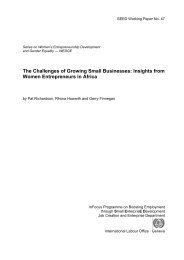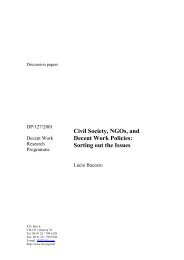manual: women workers' rights and gender equality - International ...
manual: women workers' rights and gender equality - International ...
manual: women workers' rights and gender equality - International ...
Create successful ePaper yourself
Turn your PDF publications into a flip-book with our unique Google optimized e-Paper software.
At work:<br />
The use of alcohol <strong>and</strong> drugs can increase the number of accidents, injuries, <strong>and</strong> death. It can lead<br />
to absenteeism <strong>and</strong> can impair judgment <strong>and</strong> performance resulting in poor performance resulting<br />
in poor work <strong>and</strong> decreased competitiveness <strong>and</strong> enterprise viability.<br />
In the community:<br />
Depending on the occupation, alcohol <strong>and</strong> drug use can directly harm the general public. For<br />
example, work in the transportation sector, law enforcement, medical professions, fire service <strong>and</strong><br />
hazardous installations including nuclear, chemical <strong>and</strong> biological, has the potential for causing<br />
great public harm.<br />
What measures can be taken to reduce the risk?<br />
Effective measures to reduce the risks of alcohol <strong>and</strong> drug use are often at no or little cost <strong>and</strong><br />
may include:<br />
• Obtaining information from local or national organizations about the health <strong>and</strong> safety risks<br />
resulting from the use of alcohol <strong>and</strong> drugs <strong>and</strong> distributing this information to all workers.<br />
• Requiring all workers to report to work free from the influence of alcohol <strong>and</strong> illicit drugs <strong>and</strong> to<br />
report the use of prescription <strong>and</strong> non-prescription drugs.<br />
• Eliminating the availability of alcohol during work hours <strong>and</strong> breaks <strong>and</strong> eliminating or<br />
restricting the use of alcohol <strong>and</strong> non-approved drugs during mealtimes.<br />
• Providing information on enterprise <strong>and</strong>/or community resources available to help workers with<br />
an alcohol <strong>and</strong>/or drug problem.<br />
Violence<br />
Violence - what is it?<br />
Violence can be both physical <strong>and</strong> psychological. It may involve repeated actions that alone may<br />
be relatively minor but cumulatively may cause serious harm. Violence ranges form homicide <strong>and</strong><br />
physical attack to bullying, mobbing, victimization, sexual <strong>and</strong> racial harassment.<br />
Violence – who is at risk? Are <strong>women</strong> more exposed than men?<br />
Sex, age <strong>and</strong> precarious employment are the main factors that increase worker’s risk of suffering<br />
from violence at work. At work, <strong>women</strong> are particular at risk of violence because they are<br />
concentrated in many of the high-risk jobs such as teaching, social work, nursing <strong>and</strong> other health<br />
care, as well as in banks or shops. The continued segregation of <strong>women</strong> in low-paid jobs, while<br />
men predominate in better-paid, higher status jobs, also contributes to the problem. Nevertheless,<br />
men tend to be at greater risk of physical assault, while <strong>women</strong> are particularly vulnerable to<br />
incidents of a sexual nature such as harassment. Younger workers are particularly vulnerable to<br />
victimization at work due to their lack of experience. Precarious employment <strong>and</strong> job security can<br />
lead to situations where a worker becomes a victim of a violent act, but does not dare to report it,<br />
for fear of losing the job.<br />
What are the results of violence?<br />
For the individual:<br />
Suffering <strong>and</strong> humiliation resulting from violence usually lead to lack of motivation, loss of<br />
confidence <strong>and</strong> reduced-self esteem. As with stress, if causes of violence are not eliminated or its<br />
impact contained by adequate interventions, these symptoms are likely to develop into physical<br />
illness, psychological disorders, or tobacco, alcohol <strong>and</strong> drugs abuse. These problems may<br />
ultimate cumulate in occupational accidents, invalidity <strong>and</strong> even suicide.<br />
155

















